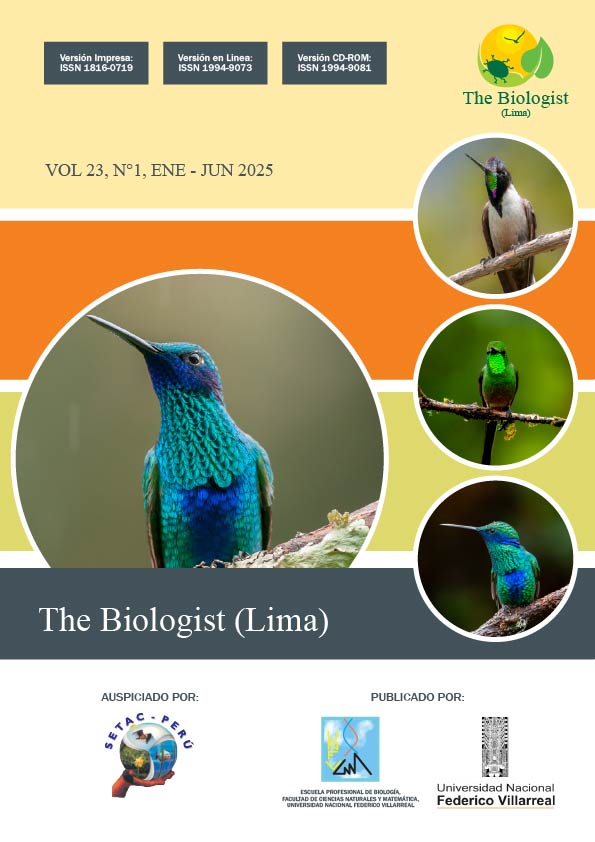Ecotoxicological effects of pesticides on freshwater snails
DOI:
https://doi.org/10.62430/rtb20252311987Keywords:
aquatic organisms, bioindicator, effects, toxicityAbstract
The increasing use of pesticides generates negative effects on biodiversity by exposing freshwater snails, which stand out as the most affected group of gastropods globally. Therefore, the objective of this research is to analyze the ecotoxicological effects of pesticide exposure on freshwater snails, evaluating the impacts on various organs. For this purpose, a search was carried out in databases such as Scopus, Sciencedirect, Web of science and Scielo, in a specific interval of years, 1999-2024. In this context, the articles analyzed focused on the evaluation of different species, especially Lymnaea stagnalis (Linnaeus, 1758), Physella acuta (Draparnaud, 1805), Chilina parchappii (d'Orbigny, 1835) and Planorbarius corneus (Linnaeus, 1758) due to their sensitivity to various pollutants and adaptation to different laboratory conditions, which facilitates their use in controlled research. Likewise, most of the studies reviewed focused on organophosphate, carbamate and pyrethroid pesticides, which cause lethal and sublethal effects such as neurotoxicity, oxidative stress, organ damage and reproductive alterations. In conclusion, ecotoxicological studies on different snail species have provided valuable information on pesticide exposure and effects, highlighting the importance of implementing appropriate conservation and management measures to protect these individuals.
Downloads
Published
How to Cite
Issue
Section
License

This work is licensed under a Creative Commons Attribution-NonCommercial-NoDerivatives 4.0 International License.
Objeto: El AUTOR-CEDENTE transfiere de manera TOTAL Y SIN LIMITACIÓN alguna al CESIONARIO (Revista The Biologist (Lima)) los derechos patrimoniales que le corresponden sobre sus obras por el tiempo que establezca la ley internacional. En virtud de lo anterior, se entiende que el CESIONARIO adquiere el derecho de reproducción en todas sus modalidades, incluso para inclusión audiovisual; el derecho de transformación o adaptación, comunicación pública, traducción, distribución y, en general, cualquier tipo de explotación que de las obras se pueda realizar por cualquier medio conocido o por conocer en el territorio nacional o internacional.
Remuneración: La cesión de los derechos patrimoniales de autor que mediante este contrato se hace será a título gratuito.
Condiciones y legitimidad de los derechos: El AUTOR-CEDENTE garantiza que es propietario integral de los derechos de explotación de la(s) obra(s) y en consecuencia garantiza que puede contratar y transferir los derechos aquí cedidos sin ningún tipo de limitación por no tener ningún tipo de gravamen, limitación o disposición. En todo caso, responderá por cualquier reclamo que en materia de derecho de autor se pueda presentar, exonerando de cualquier responsabilidad al CESIONARIO.
Licencia de acceso abierto: El AUTOR-CEDENTE autoriza que manuscrito publicado en la Revista Científica The Biologist (Lima) (versión Impresa ISSN 1816-0719, versión en línea ISSN 1994-9073) permanece disponible para su consulta pública en el sitio web http://revistas.unfv.edu.pe/index.php/rtb/index y en los diferentes sistemas de indexación y bases de datos en las que la revista tiene visibilidad, bajo la licencia Creative Commons, en la modalidad Reconocimiento-No comercial- Sin Trabajos derivados –aprobada en Perú, y por lo tanto son de acceso abierto. De ahí que los autores dan, sin derecho a retribución económica, a la Escuela Profesional de Biología, Facultad de Ciencias Naturales y Matemática de la Universidad Nacional Federico Villarreal (EPB - FCCNM - UNFV), los derechos de autor para la edición y reproducción a través de diferentes medios de difusión.









































